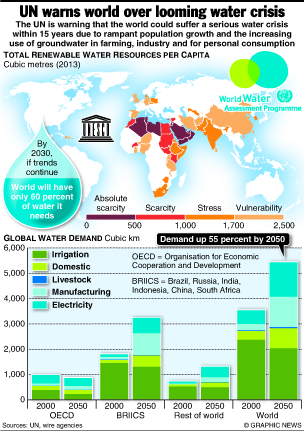Sunday Times 2
Time now to act on looming water crisis, UN warns
View(s):PARIS, March 20 (AFP) -Without reforms, the world will be plunged into a water crisis that could be crippling for hot, dry countries, the United Nations warned Friday.
In an annual report, the UN said abuse of water was now so great that on current trends, the world will face a 40-percent “global water deficit” by 2030 — the gap between demand for water and replenishment of it.
“The fact is there is enough water to meet the world’s needs, but not without dramatically changing the way water is used, managed and shared,” it said in its annual World Water Development Report.
“Measurability, monitoring and implementation” are urgently needed to make water use sustainable, said Michel Jarraud, head of the agency UN-Water and the World Meteorological Organisation (WMO).
Surging population growth is one of the biggest drivers behind the coming crisis, the report said.
Earth’s current tally of around 7.3 billion humans is growing by about 80 million per year, reaching a likely 9.1 billion by 2050.
To feed these extra mouths, agriculture, which already accounts for around 70 percent of all water withdrawals, will have to increase output by some 60 percent.
Climate change — which will alter when, where and how much rainfall comes our way — and urbanisation will add to the coming crunch.
The report pointed to a long list of present abuses, from contamination of water by pesticides, industrial pollution and runoff from untreated sewage, to over-exploitation, especially for irrigation.
More than half of the world’s population takes its drinking supplies from groundwater, which also provides 43 percent of all water used for irrigation.
Around 20 percent of these aquifers are suffering from perilous over-extraction, the report said.
So much freshwater has been sucked from the spongy rock that subsidence, or saline intrusion into freshwater in coastal areas, are often the result.
By 2050, global demand for water is likely to rise by 55 percent, mainly in response to urban growth.
“Cities will have to go further or dig deeper to access water, or will have to depend on innovative solutions or advanced technologies to meet their water demands,” the report said.
The overview, scheduled for release in New Delhi, draws together data from 31 agencies in the United Nations system and 37 partners in UN-Water.
It placed the spotlight on hot, dry and thirsty regions which are already struggling with relentless demand.
In India, the number of so-called tube wells, pulling out groundwater, rose from less than a million in 1960 to nearly 19 million 40 years later.
“This technological revolution has played an important role in the country’s efforts to combat poverty, but the ensuing development of irrigation has, in turn, resulted in significant water stress in some regions of the country, such as Maharashtra and Rajasthan,” the report said.

